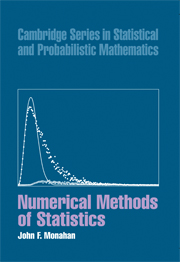Book contents
- Frontmatter
- Contents
- Preface
- 1 Algorithms and Computers
- 2 Computer Arithmetic
- 3 Matrices and Linear Equations
- 4 More Methods for Solving Linear Equations
- 5 Regression Computations
- 6 Eigenproblems
- 7 Functions: Interpolation, Smoothing, and Approximation
- 8 Introduction to Optimization and Nonlinear Equations
- 9 Maximum Likelihood and Nonlinear Regression
- 10 Numerical Integration and Monte Carlo Methods
- 11 Generating Random Variables from Other Distributions
- 12 Statistical Methods for Integration and Monte Carlo
- 13 Markov Chain Monte Carlo Methods
- 14 Sorting and Fast Algorithms
- Table of Programs and Demonstrations
- Author Index
- Subject Index
8 - Introduction to Optimization and Nonlinear Equations
Published online by Cambridge University Press: 21 March 2011
- Frontmatter
- Contents
- Preface
- 1 Algorithms and Computers
- 2 Computer Arithmetic
- 3 Matrices and Linear Equations
- 4 More Methods for Solving Linear Equations
- 5 Regression Computations
- 6 Eigenproblems
- 7 Functions: Interpolation, Smoothing, and Approximation
- 8 Introduction to Optimization and Nonlinear Equations
- 9 Maximum Likelihood and Nonlinear Regression
- 10 Numerical Integration and Monte Carlo Methods
- 11 Generating Random Variables from Other Distributions
- 12 Statistical Methods for Integration and Monte Carlo
- 13 Markov Chain Monte Carlo Methods
- 14 Sorting and Fast Algorithms
- Table of Programs and Demonstrations
- Author Index
- Subject Index
Summary
Introduction
This chapter serves as an appetizer to the main course, maximum likelihood and nonlinear least squares. This is stated so boldly because many statistical problems of this type originate in estimation problems with maximum likelihood (or a similar criterion) as the goal. Our discussion begins with some of the background calculus and definitions. Next, the discussion turns to the safe and slow methods for optimization in a single variable, for which the statistical term “nonparametric” has the correct connotations. Next, the root-finding problem is addressed with the standard techniques, Newton and secant methods, followed by a brief presentation of convergence rates. After a short digression on stopping and condition, the multivariate problem is first approached with Newton's methods. After a second digression on numerical differentiation, quasi-Newton methods are discussed for optimization and nonlinear equations. Discussions of condition, scaling, and implementation conclude the chapter.
Some topics are not addressed in this discussion. One problem is the solution of polynomial equations, which arise rarely in an isolated form in statistics. Constrained optimization can often be avoided through reparameterization. The specialized problem of nonlinear regression is postponed until the next chapter, to be treated as a special topic in maximum likelihood.
Before attacking the problems at hand, it is wise to review some foundations to gain a clearer perspective of the situation. The cornerstone for everything are the first results of calculus, the primary tools in applied mathematics. These results will first be stated in their univariate form.
- Type
- Chapter
- Information
- Numerical Methods of Statistics , pp. 170 - 198Publisher: Cambridge University PressPrint publication year: 2001

